How Amelia Earhart Just Turned Up in the Halls of Congress
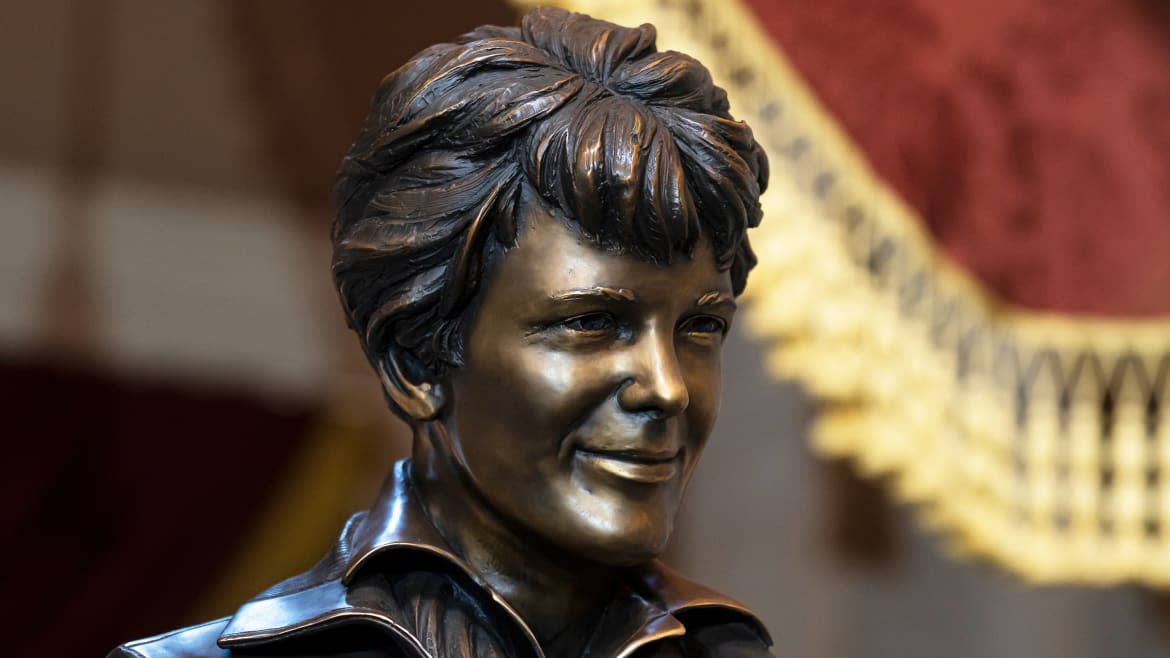
- Oops!Something went wrong.Please try again later.
- Oops!Something went wrong.Please try again later.
Here’s the rule: Each state gets two statues in the U.S. Capitol Building. They don’t have to be one Democrat and one Republican—they don’t even have to be politicians—but you get only two. And the subjects have to be dead.
And here’s the unwritten rule: When you’re sculpted in marble or cast in bronze and seated in the Capitol, you might seem immortal, but you’re only semi-immortal. You’re there forever and everlastingly… until someone comes along whom your state thinks is sexier.
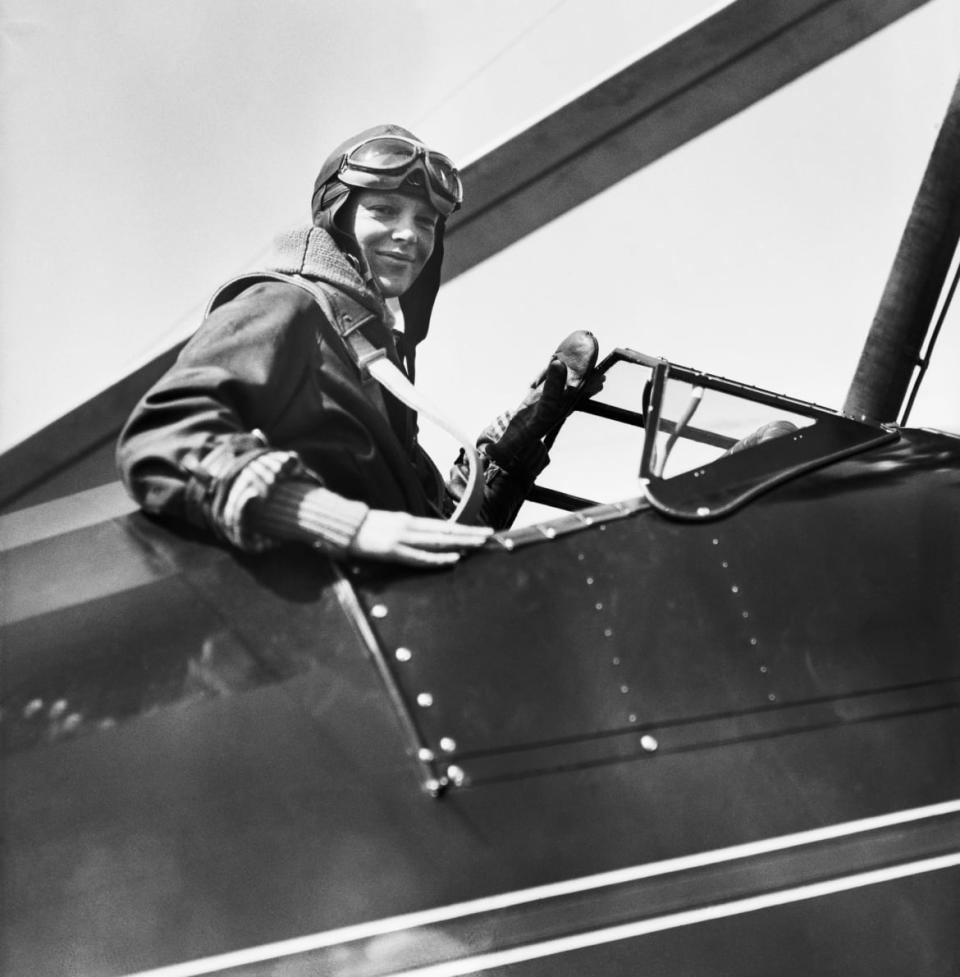
Amelia Earhart in the cockpit of her autogiro after setting a new altitude record for women in planes of this type.
This brings us to Amelia Earhart. The world’s most famous aviator may have disappeared over the Pacific Ocean in 1937, but she has landed in 2022, in bronze, wearing pants, in D.C.
Kansas’ most famous native daughter stands proudly this week in the Capitol’s second-floor, amphitheater-shaped Statuary Hall, 125 years after her birth. It was a long and winding journey to reach this American Valhalla, where the worthiest of worthies assemble for posterity. It’s an exciting story. Grab a cold glass of buttermilk to set the mood: Amelia rarely drank tea and never touched coffee or alcohol.
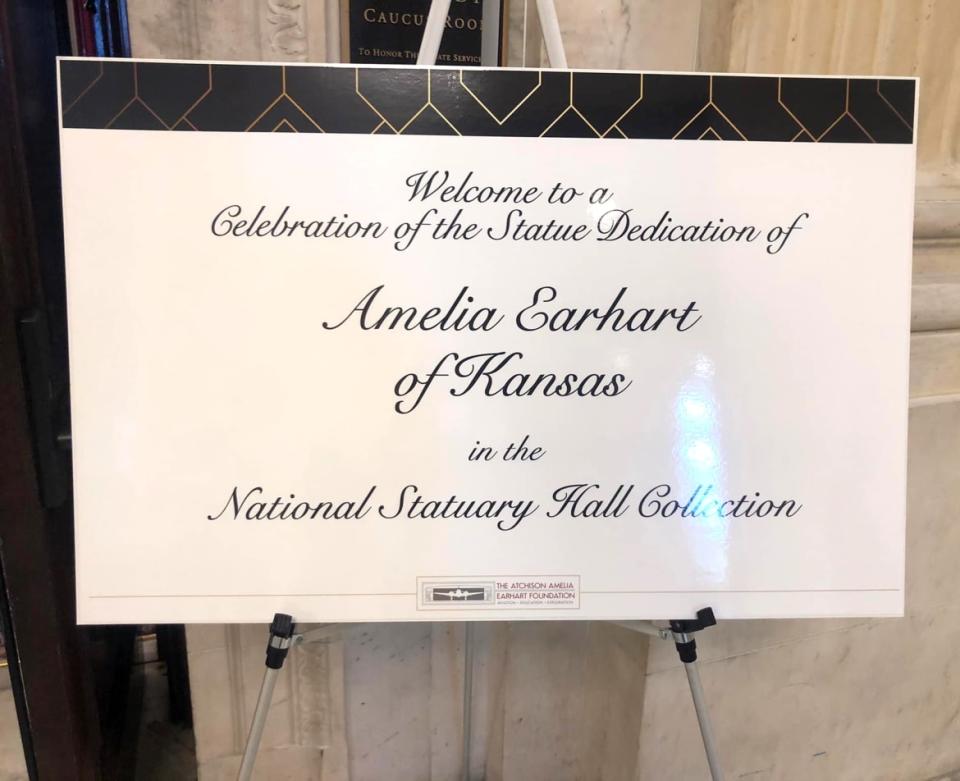
Since 1864, the federal law allowing states to have two statues has permitted Statuary Hall to host 38 cast or carved figures. Since 1933, the rest are scattered throughout the building. Rhode Island donated the first statues in 1870 in honor of Revolutionary War hero Nathaniel Greene and the state’s Puritan founder Roger Williams. Half of the allotted statues were placed in the Capitol Building by the late 1800s, all depicting white men.
Coincidentally, Earhart and the two Kansas men who preceded her in statuary hall were all connected to Atchison, Kansas, a once powerful town in the heyday of the railroads.
The Amelia Earhart Kimono That Spikes a Racist Legend
Due to its railroad connection, Atchison was a big deal in the old days. Here, Earhart spent much of her early childhood living with her wealthy grandparents. The family wanted her around as a cheerful companion for depressed Grandmother Otis. Amelia could live with servants and a garden and a horse stable and attend the finest private school in the area on her grandparents’ dime. Her financially struggling parents lived in nearby Kansas City with her baby sister Muriel, but they all spent weekends and summers together. During her later youth, when Amelia joined her family full-time, her father’s growing alcoholism forced him to find work as a low-level railroad lawyer, exposing her to poverty and isolation that shattered her once-privileged perspective.
In 1905 Kansas sent its first statue to Washington: a marble statue of Senator John James Ingalls. From 1873 to 1891, Ingalls was a Republican senator who championed anti-slavery causes and statehood for Kansas. Known in Congress for his colossal vocabulary, the silver-tongued orator even coined the Kansas state motto, Ad Astra Per Aspera (roughly translating as “to the stars through hardship”).
Nine years later, the second Kansas statue was ready: a seven-foot grey marble likeness of George Washington Glick. A wounded Civil War veteran, Glick was the ninth governor of Kansas and the first one from the Democratic party. He was also Earhart’s grandfather’s old law partner at Otis & Glick. It’s likely Amelia Earhart knew both Ingalls and Glick.
But decades later, people had trouble remembering either man. A 1971 proposal to replace Glick with President Dwight D. Eisenhower (raised in Abilene, Kansas) failed to gain traction, but the call for official statue replacement arose again in the late ’90s: Kansas State Representative Todd Tiahrt of Wichita was annoyed that visitors taking Capitol Hill tours didn’t care about the two Kansas statues in Statuary Hall. “You walk right by the one from Oklahoma, Will Rogers, and everybody recognizes it,” Tiahrt sniffed. Noting that visitors rubbed Will’s bronze toes for luck, he thought it would be helpful if the state had a Kansas icon everybody recognized. Someone like Ike.
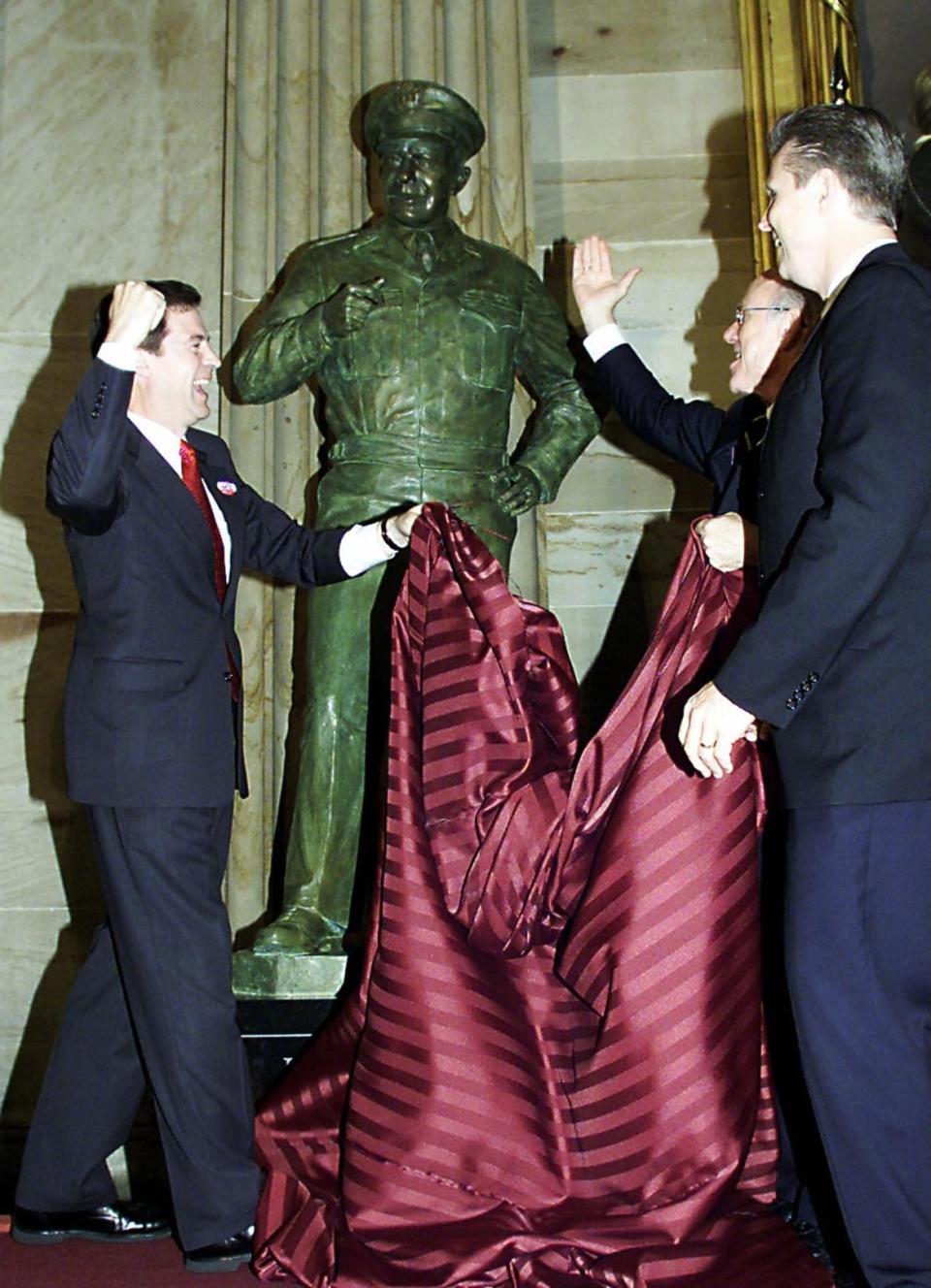
Kansas Senators Sam Brownback and Pat Roberts celebrate the newly unveiled statue of Dwight D. Eisenhower in the Rotunda of the United States Capitol June 04, 2003.
Democrats didn’t mind honoring the Republican Eisenhower, but they had a problem with just tossing Glick, the marble man Ike replaced, to the curb. But Representative Jerry Henry, a Democrat, came up with an ingenious compromise. Why not return both statues? Avoid political conflict and replace the forgotten Republican Ingalls with the famous Queen of the Air, Atchison’s own Amelia Earhart. Who didn’t like Amelia Earhart?
At least one person didn’t. “I think it absolutely ridiculous they want to remove my grandfather,” said 93-year-old Sally Ingalls von Ostman to any reporter who would listen to her. “If they knew their history, they’d be proud of him. Why he had people spellbound with his speeches! He had a great wit, too.” Von Ostman wrote letters to relatives and editors, nearly 40 angry dispatches until she said her angst made her sick. When she died eight years later at 101, her marble grandfather was still being ignored by tourists.
Shortly after the millennium, at Kansas’ urging, Congress passed a law allowing statues to be moved around within the Capitol, though never out of the building without the state’s permission. Crucially, the law also allowed for statue replacement—with the caveat that only states could decide who would be replaced to ensure that some damn Democrat wouldn’t be shipping off a Confederate hero. But the uncontroversial Amelia Earhart’s chances of being immortalized improved since Republican and Democratic Kansan politicians still wanted her crowd-pleasing face inside the hallowed doors.
Congress was soon inundated with passionate letters, including a lot of heated and racially charged debate among rival politicians. One Cheers fan with a different political agenda wrote to the Wichita Eagle and argued that a statue that would really stand out in the Capitol building would be a bronzed depiction of Wichita’s Kirstie Alley.
An Eisenhower statue was installed at the Capitol in 2003. In 2010, Amelia got the break she needed when EVE (Equal Visibility Everywhere), a Miami-based nonprofit that promotes gender parity in icons and symbols of the United States, assured Atchison’s citizens they would step in, if permitted, to raise all the funds, and even help select a sculptor. The winner, chosen in 2013, were brothers George and Mark Lundeen from Colorado, known for their bronze statue of Dr. Sally Ride, the first American woman in space, and a bronze tribute to the first astronauts to land on the moon that stands at the Kennedy Space Center in Florida.
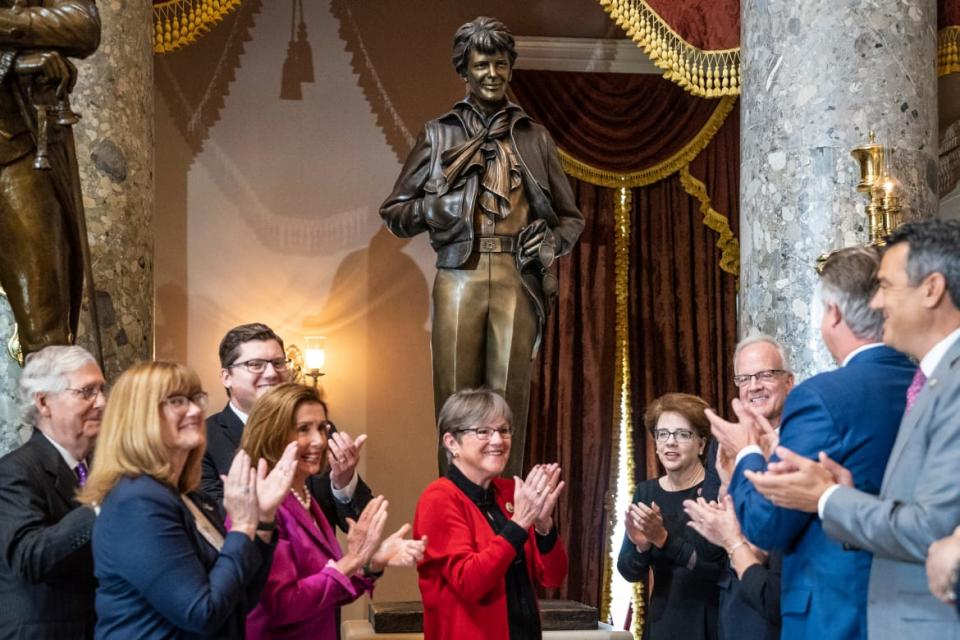
Lawmakers watch as a statue in honor of Amelia Earhart is unveiled in Statuary Hall on Capitol Hill on Wednesday, July 27, 2022 in Washington, D.C.
The funds EVE promised to secure never materialized. Years of delays followed. In 2016 the Atchison Amelia Earhart Foundation was formed to raise private funding for the bronze statue and limestone base. It took several years before they raised the cash and the statue and the limestone pedestal were completed.
This year, on Monday, July 18, the 500-pound hollow Amelia Earhart was taken out of storage at the Kansas City warehouse where she had been quietly stashed for a year after the Lundeen brothers delivered their finished artwork to the Atchison Amelia Earhart Foundation. Then she was loaded onto a truck for the final leg of her journey to the Capitol.
But before she could enter the storied building, the 12,000-pound Ingalls monument had to be removed under the Earhart committee’s care. The contractor United Steerage hoisted Ingalls while he was still attached to his base. He got out unscathed. Once that last obstacle was cleared away, it was Earhart’s turn for congressional glory.
Two weeks earlier, a statue of Dr. Mary McLeod Bethune had replaced Florida’s Confederate General Edmund Kirby Smith (by state decree). Installation of Dr. Bethune’s statue took until 2 a.m. due to its complexity.
Earhart’s installation, in contrast, went like lightning. It was the fastest in the history of congressional statuary, according to the Earhart Foundation’s Statue Chair, Jacque Pregont.

Matthew Smith (c) from pedestal installation
“Amelia set another speed record!” Pregont joked. “Matt Smith from the Nelson/Atkins Museum was in charge of the pedestal and installation, and he sent me a text at 9:32: ‘Done.’ I thought he was kidding.”
Earhart had her new berth, sandwiched between John Sevier, a Tennessee governor, and Wisconsin’s Robert La Follette, a former congressman, senator, and governor. She became just the 11th woman out of 100 statues in the Capitol. Once installed, the statue, which depicts Earhart in a flight jacket, scarf, and slacks, was quickly draped in a giant black cloth covering her face and torso until her official unveiling.
At 11 a.m. on July 27, Earhart’s official welcome to her new home began with a ceremony presided over by Speaker of the House Nancy Pelosi in a fabulous—and an utterly apt nod to Earhart’s style—fuchsia pantsuit. Pelosi celebrated Earhart as an American “who personifies the daring and determined spirit of our nation as she takes her rightful place here in the Capitol.”
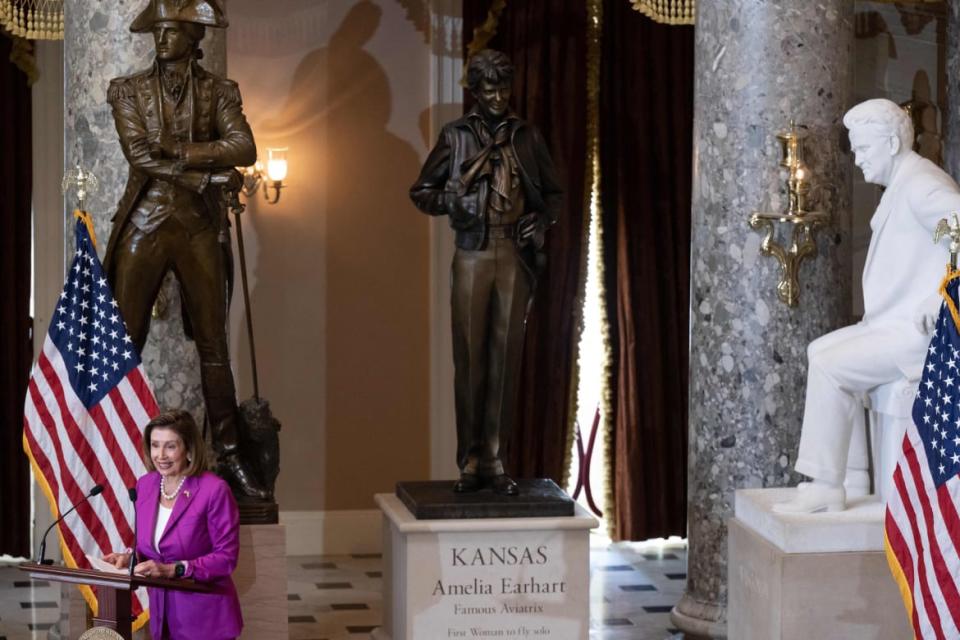
Nancy Pelosi speaks during the unveiling of a statue of Amelia Earhart during a ceremony in Statuary Hall at the US Capitol.
When it came time for the unveiling, I could see from my bird’s-eye perch in the press gallery that it wasn’t just one person who pulled the rope but rather a bunch of people, including Speaker Pelosi, Kansas Governor Laura Kelly (the rare Democratic woman in a very red state), Kansas senators Roger Marshall and Jerry Moran, Representative Sharice Davids, the Atchison Amelia Earhart Foundation’s President Karen Seaburg, and Pregont. Senate Minority Leader Mitch McConnell and House Speaker Kevin McCarthy, those famous feminists who would extol Earhart’s virtues minutes later, notably did not have hands on the rope.
When the cloth hiding Amelia’s face was whisked away, Governor Kelly exclaimed loudly, “Oh my gosh, her belt buckle is Kansas!” Her belt buckle was indeed in the shape of Kansas and had a sunflower on it, a nod to the state’s nickname, the Sunflower State.
After the statue’s dramatic reveal, it was almost impossible to miss the large, capitalized word “Aviatrix” on her pedestal. Archival research shows that Earhart preferred the words aviator, pilot, or flyer to describe her occupation. But in fairness, she was no fusspot and let it go if anyone used it in an article or even entered it on her license. Later, I was told that while the family had approved the pedestal’s wording years earlier, they also preferred “aviator.” But it is too late. Nobody is about to re-carve the half-ton pedestal.
This fall, a twin statue to the one in Washington will be dedicated at the brand-new Amelia Earhart Hangar Museum in Atchison, built to house the world's last remaining Lockheed Electra 10-E aircraft—identical to the plane Amelia piloted on her fateful round-the-world flight before she vanished on July 2, 1937. On that statue, also cast by the Lundeen brothers, the word aviatrix may be covered on the pedestal with a simple plaque reading, “Aviator.”
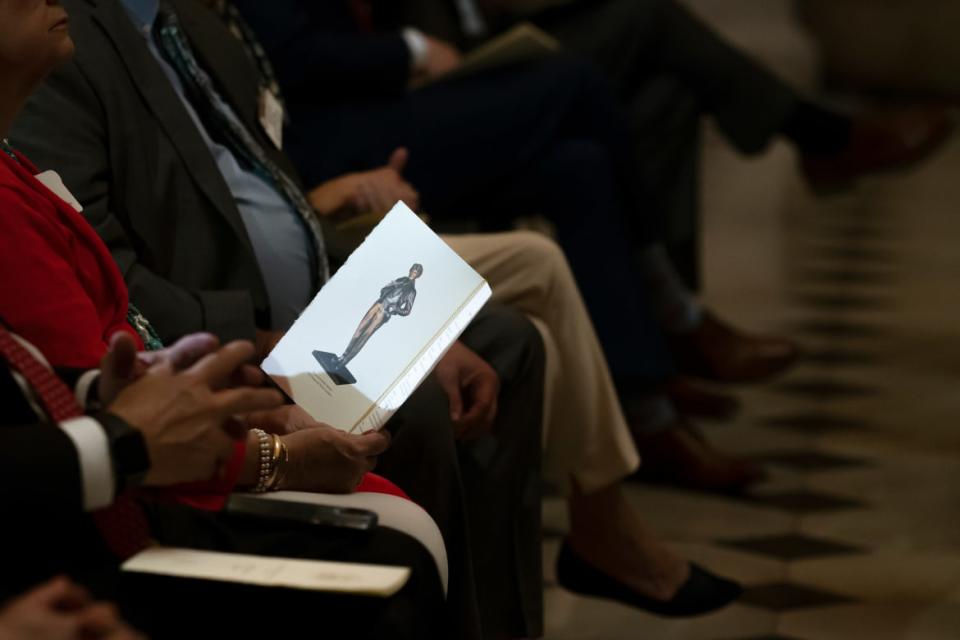
An attendee holds a pamphlet displaying an Amelia Earhart statue before its unveiling in Statuary Hall at the U.S. Capitol on July 27, 2022.
The family did get one wish fulfilled: Amelia was depicted in pants, not in a dress or even her iconic jodhpurs. Earhart knew how to glam up for special events and look fabulous in a dress—she was a Vogue favorite and often listed as one of the best-dressed women of the day—but when unwinding with family, she preferred the comfort of pants. There is also much anecdotal evidence in her archives that the pilot loathed her thick ankles, conveniently hidden by pants. Earhart wore pants everywhere, even as a regular visiting lecturer at Purdue University, where she defied a rule that women were restricted to skirts or dresses on campus. When students who wished to sport pants complained to Dean of Women Dorothy Stratton, she replied, “When you can fly an airplane solo across the Atlantic Ocean, then you can wear slacks in the Purdue dining hall.”
Is Amelia Earhart Mystery Solved? Why the Aviator Lifts Our Hearts
Five of Amelia’s great-nephews and great-nieces were present at the Capitol festivities, along with one great-great nephew, James, who looked to be 10. All these broadly smiling faces were descendants of Amelia’s sister, Muriel Earhart Morrissey, by way of Muriel’s two children: David Morrissey, who died in 1978, and Amy Morrissey Kleppner, who just celebrated her 91st birthday.
One of Amelia's middle-aged grandnephews, Bram Kleppner, was long past worrying about the dated word choice on the pedestal. Beaming as everyone including the usually-at-odds Pelosi and McConnell shook his hand, he said that all the folks in the room related to him were proud and delighted with the statue and the event: “Fundamentally, Muriel’s descendants all share a commitment to justice and to fight for gender equality.” The Earharts I met self-identified as Democrats, and Earhart herself leaned towards socialism and was a big supporter of Franklin D. Roosevelt. Jane Dudley Portman was the only attendee descended from Amelia’s famously fiery Republican husband, George Palmer Putnam. A former Democrat, she was there with her Republican husband, Rob Portman, the senator from Ohio. (The story goes that he would become a Methodist if she converted to the GOP.)
Post-ceremony refreshments followed in the historic Kennedy Caucus Room in the 1908 Beaux Art Russell Senate Office Building, the room where Kennedy launched his presidential campaign and where the Titanic, McCarthy, and Watergate hearings were held. All smiled at the videotaped greetings from Amelia’s 91-year-old niece Amy Morrissey Kleppner recorded from the safety of her home to protect her from COVID-19. Then the many Republicans and Democrats in the room mingled, toasting everyone’s hero, Amelia Earhart. For a moment, the Capitol was fun.
John James Ingalls once said, “In the Democracy of the dead, all men are at last equal.” Well, maybe not on Capitol Hill. Amelia Earhart, the lady who replaced the old silver-tongued orator in Statuary Hall, will now be viewed by 2 to 3 million visitors each year, including many children who will be first introduced to an aviation legend by her statue. The man Amelia replaced in the Capitol, Ingalls, is crated and en route back to Kansas, where he will be installed in the Atchison Middle School (formerly Ingalls High School).
Meanwhile, George Washington Glick is rumored to stand in the basement of the Kansas State Historical Society in Topeka.
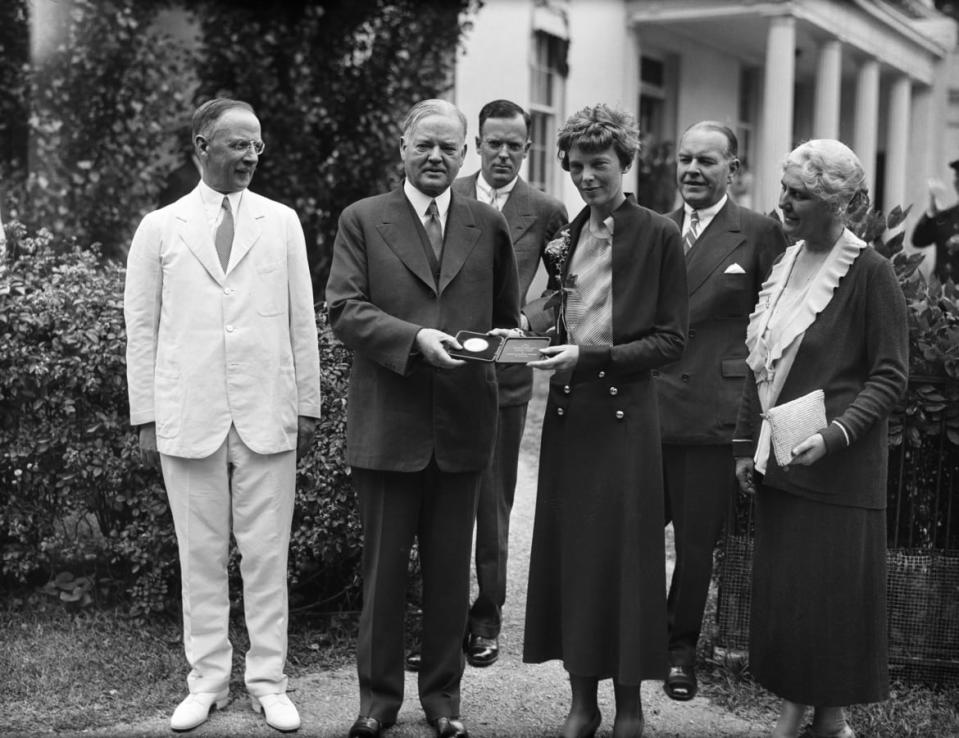
President Herbert Hoover presenting the National Geographic Society gold medal to Amelia Earhart in recognition of her continuous solo flight across the Atlantic.
This is not Amelia Earhart’s first tour of Washington. When alive, she was lauded by President Herbert Hoover and, after 1932, often stayed at the Roosevelt White House. She heavily lobbied both presidents to support aviation and the Equal Rights Amendment proposed by Earhart’s feminist mentor Alice Paul in 1923. Now that she is back in town, perhaps her face will remind congressional leaders to move on that pressing legislation. On Jan. 15, Virginia became the 38th state to pass the ERA, making it law, but eight months later and nearly a century after its introduction it is still mysteriously still unratified. Equality among the dead is a myth, refuted by each figure in Statuary Hall. But equality among the living is still an option.
Get the Daily Beast's biggest scoops and scandals delivered right to your inbox. Sign up now.
Stay informed and gain unlimited access to the Daily Beast's unmatched reporting. Subscribe now.

